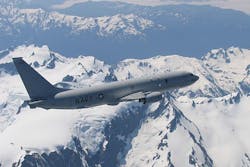Navy orders 16 Boeing P-8A maritime patrol jets, as program reaches full-rate production
PATUXENT RIVER NAS, Md., 26 Feb. 2014. U.S. Navy aircraft experts ordered 16 P-8A Poseidon maritime patrol jets from the Boeing Co. in Seattle Tuesday in a contract modification worth $2.1 billion.
The P-8A is a military version of the Boeing 737-800 single-aisle passenger jet, and is designed for maritime patrol and anti-submarine warfare as a replacement for the Lockheed Martin P-3 Orion turboprop. Awarding the contract were officials of Naval Air Systems Command at Patuxent River Naval Air Station, Md.
Tuesday's contract modification involves options for P-8A multi-mission maritime aircraft full rate production Lot I aircraft, as well as 16 ancillary mission equipment kits. This is the aircraft's first full-rate production lot and with this contract the program will enter full production, Boeing officials say.
This order takes the Navy's total P-8A fleet to 53. Boeing has delivered 13 P-8As to the Navy, which deployed its first patrol squadron to Kadena, Japan, last December, and has been conducting operational missions since then.
The P-8A will enhance the service's anti-submarine, anti-surface warfare and intelligence, surveillance and reconnaissance capabilities. Overall, the Navy plans to purchase 117 P-8As.
Boeing assembles the P-8A aircraft in the same Renton, Wash., facility where it builds all its 737 aircraft. Boeing's P-8A team includes CFM International, Northrop Grumman, Raytheon, Spirit AeroSystems, BAE Systems, and GE Aviation.
Navy officials plan to use the P-8A in tandem with the Northrop Grumman RQ-4N Broad Area Maritime Surveillance (BAMS) unmanned aerial vehicle (UAV) -- a maritime-patrol version of the Global Hawk long-range surveillance UAV. Plans call for using BAMS to detect potentially hostile submarines and surface ships, and upon detection, to call in the P-8A to take a closer look or to attack hostile vessels with torpedoes and missiles.
The 737 fuselage and tail sections will be built by Spirit AeroSystems in Wichita, Kan., then transferred to Renton where all structural features will be incorporated in sequence during fabrication and assembly.
Related: Boeing to provide Navy P-8A Poseidon patrol jet flight simulators in $225 million contract
The P-8A’s flight management system and the stores management system have been developed by GE Aviation Systems in Grand Rapids, Mich. (formerly Smiths Aerospace). The cabin has as many as seven operator consoles.
The Poseidon’s MX-20HD digital electro-optical and infrared (EO/IR) multi-spectral sensor turrets come from L-3 Communications Wescam in Burlington, Ontario. The MX-20HD is gyro-stabilized and can have as many as seven sensors, including infrared, CCDTV, image intensifier, laser rangefinder, and laser illuminator.
The aircraft has the upgraded APS-137D(V)5 maritime surveillance radar and signals intelligence (SIGINT) system from the Raytheon Co. Space and Airborne Systems (SAS) segment in McKinney, Texas.
The APS-137D(V)5 radar, which is installed on the P-8’s enlarged nose fairing, provides synthetic aperture radar (SAR) for imaging stationary ships and small vessels, coastal and overland surveillance, and high-resolution imaging synthetic aperture radar (ISAR) for imaging surfaced submarines and fast surface vessels operating in coastal waters.
Related: Boeing to make flying torpedoes able to attack enemy submarines from 30,000 feet
The P-8A will have the CAE Inc. advanced integrated magnetic anomaly detection (MAD) system. The Navy plans to arm the P-8A with the MK 54 torpedo.
On this contract Boeing will do the work in Renton, Wash.; Baltimore; Greenlawn, N.Y.; Cambridge, England; Rockford, Ill.; North Amityville, N.Y.; and other U.S. locations, and should be finished by April 2017.
For more information contact Boeing Co. online at www.boeing.com, or Naval Air Systems Command at www.navair.navy.mil.

